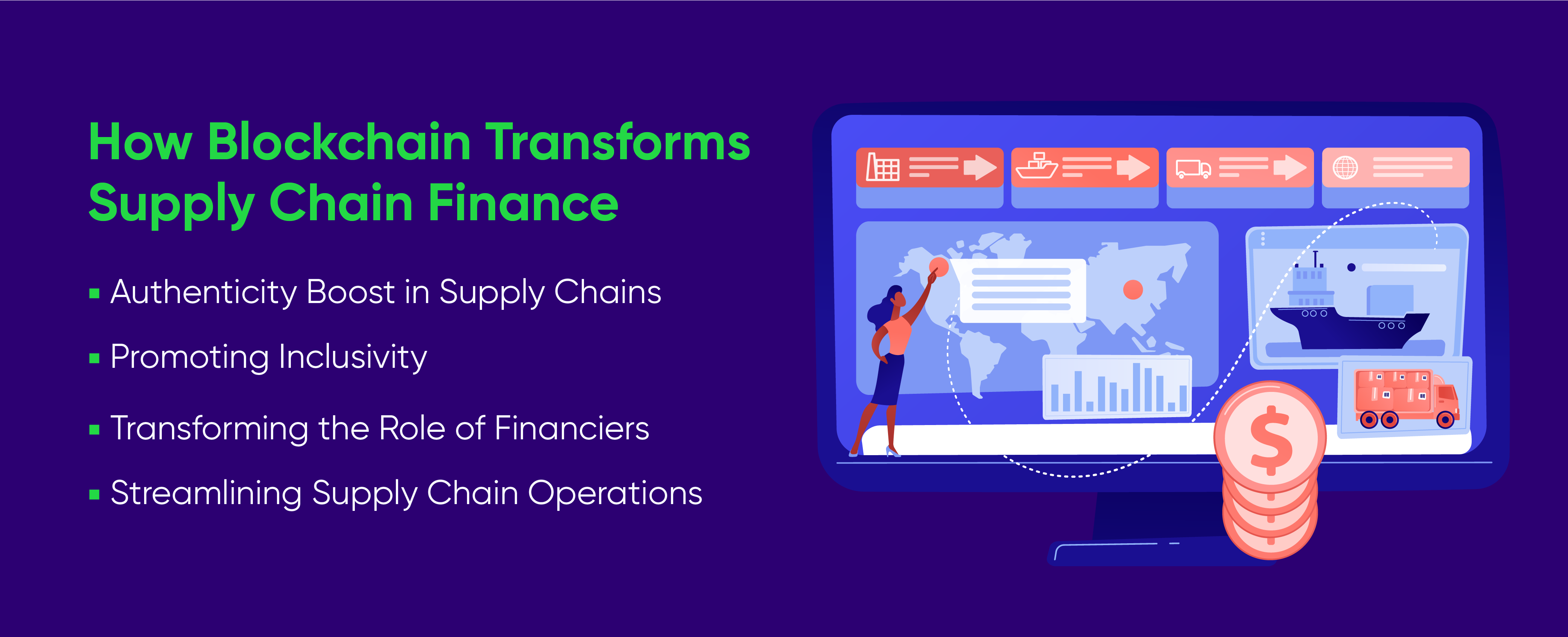
Introduction
Blockchain & Web3 Services Trusted By Leaders
- Develop innovative solutions using our state-of-the-art blockchain expertise.
- Achieve accelerated growth with robust & scalable Web3 consulting.
- Unlock 360-degree security with our top-rated blockchain development.
Blockchain Technology in Supply Chain Finance – A Game Changer?
Supply chain finance involves collaboration among a buyer, supplier, and lender. In this setup, the lender provides funds to the supplier to manufacture products required by the buyer. Once the goods are purchased, the supplier repays the lender. Although straightforward, this system has limitations – specifically, a lack of visibility among the parties involved. Blockchain technology addresses this issue by ensuring complete transparency, allowing every transaction to be visible to all parties. By 2028, the adoption of blockchain in supply chain finance is expected to reach a market value of US$7 billion globally. This growth is anticipated as companies, from large corporations to small and medium-sized enterprises, adopt the technology to reduce costs, accelerate production, expand trade, and guarantee ethical practices in production.Key Takeaways
- What is Supply Chain Finance? Supply Chain Finance optimizes cash flow by facilitating better payment terms between buyers and suppliers.
- How does Blockchain help in the Supply Chain? Blockchain enhances supply chain transparency and accuracy by maintaining a secure, real-time record of transactions.
- Benefits of Blockchain: Blockchain technology boosts security, reduces fraud, and increases transaction speed across industries.
- Blockchain & Financial Services: In financial services, blockchain technology streamlines processes and minimizes risks, transforming how capital is managed.
What is Blockchain Technology?
Blockchain technology consists of a growing chain of digital records, known as blocks, linked securely by advanced cryptography, enhancing their security. Each block contains a unique timestamp indicating its creation time and transaction data, such as a purchase record. This setup offers high transparency or ‘truth’ throughout the entire transaction process. Every participant in the blockchain can trace the sequence of transactions from beginning to end, with all details openly accessible. While blockchain is famously associated with cryptocurrencies like Bitcoin, its application extends beyond this. Although not yet widespread in commercial transactions, blockchain is particularly effective for managing supply chain finance due to its transparency and security features.How Does Blockchain Work in Supply Chain Finance?
Blockchain technology has evolved beyond its initial application in digital currencies and is now utilized across various sectors such as automotive, telecommunications, insurance, retail, entertainment, and healthcare. In these industries, blockchain is leveraged for a range of services including billing, payments, logistics, and planning. However, its most significant application is in supply chain finance:-
Traditional Supply Chain Finance
In a typical supply chain finance scenario, visibility is restricted to the buyer and lender. At every step of the transaction, only two of the three parties involved – the buyer, supplier, or lender – can view the activities. This limitation not only slows down production and planning but also places the uninvolved party at a disadvantage. It could potentially hide unethical practices or financial troubles of the buyer or supplier.
Challenges of Conventional Supply Chain Finance (SCF)
Here are some of the key difficulties businesses encounter:
-
- Inefficient Approval Processes: Traditional SCF often suffers from slow and cumbersome approval processes, with each step needing multiple clearances from different parties. This reliance on verifying numerous documents significantly extends the time it takes to complete transactions.
-
- Excessive Paperwork: The dependence on physical documentation can lead to logistical problems. Paper documents are susceptible to errors, can be lost, and often cause delays as they are transported. Additionally, manual checking and matching of these documents are both time-consuming and prone to mistakes.
-
- Issues with Data Integrity: Conventional SCF methods typically lack a centralized, secure system for storing transaction data. This absence can result in data being altered, inconsistencies appearing, and conflicts arising among trading partners.
These drawbacks can increase operational costs, disrupt the smooth operation of supply chains, and diminish trust in the supply chain network.
|
Transaction phase |
Blind party |
|
Buyer orders products from the supplier |
None |
|
Supplier requests financing from the lender |
Buyer |
|
Supplier invoices and ships products to the buyer |
Lender |
|
Buyer completes payment to supplier for products |
Lender |
|
Supplier pays off the lender and settles the loan |
Buyer |
|
Buyer returns any unsold products to supplier for a refund |
None |
Now Improve Supply Chain With Blockchain
In contrast, a blockchain-enabled supply chain finance system allows all three parties to view the entire blockchain. As each transaction phase unfolds, a new block is added, ensuring transparency. No party is left uninformed; everyone can see the current stage of the transaction and respond appropriately, whether that means timing deliveries or adjusting production. This transparency helps eliminate the possibility of concealing unethical acts or financial issues, thereby reducing risks and potentially lowering related costs like insurance or financing fees.How Blockchain Transforms Supply Chain Finance

-
Authenticity Boost in Supply Chains
Supply chain finance involves a complex network of multiple stakeholders, including buyers, suppliers, and intermediaries. Traditionally, the flow of information in such networks lacks transparency, and different parties may act out of self-interest, which can complicate and lengthen the process.
Introducing blockchain technology can address these challenges. Everyone in a blockchain network can access a shared, distributed ledger that records all transactions transparently. Because blockchain data cannot be altered, it ensures accuracy and reliability, streamlining processes and enhancing the robustness of supply chains.
-
Promoting Inclusivity
Traditional supply chain financing often underserves small and medium enterprises (SMEs), focusing financial support predominantly on larger corporations. This imbalance means SMEs could benefit significantly from more accessible early-payment options in supply chain finance.
Blockchain technology can democratize access to financial resources, ensuring fairer support across all business sizes by making financing more accessible to a broader range of companies, including SMEs.
-
Transforming the Role of Financiers
In conventional settings, financial institutions dominate supply chain finance by funding suppliers on behalf of buyers, who then repay with interest and fees.
However, blockchain opens up the field to a wider array of participants, including corporate foundations and individual investors, who can engage in supply chain finance and potentially reap returns. Platforms like CredSCF exemplify how blockchain enables diverse financing sources to participate.
-
Streamlining Supply Chain Operations
Handling economic data within multi-party systems like supply chain finance is often cumbersome, with inaccuracies significantly impeding efficiency. Blockchain can revolutionize this aspect by providing an immutable, transparent ledger that maintains real-time transaction data, which can help streamline financial management and optimize operational flows for better business efficiency.
Disadvantages of Blockchain In Supply Chain
However, there are some drawbacks to using blockchain in supply chain finance, which include:- Small and medium-sized enterprises (SMEs) might be slow to adopt due to misconceptions about blockchain or a lack of information
- Requires changes in IT systems and methods used by sales teams and purchasing departments
- Needs coordination between the trading systems of buyers, suppliers, and lenders
Security of Blockchain in Supply Chain Finance
Blockchain acts as a digital ledger that records transactions among various parties in a way that is secure and resistant to tampering. Each block in the chain is connected to the next through strong cryptographic links. Without a unique access key, it’s impossible for outsiders to access or alter the ledger.An Example of How Blockchain is Used in Supply Chain Finance
- Global Retail orders cardboard boxes from ABC Cartons, a box manufacturer.
- The order is added to a blockchain designed for this transaction.
- ABC requests funding from their bank to cover the cost of materials needed for the boxes. The bank agrees, and this transaction is recorded as a new block in the chain, visible to Global.
- ABC gets the funds, produces the boxes, and ships them to Global along with the invoice. The shipping and billing details are also recorded in the blockchain, visible to the bank.
- Global receives the boxes and makes a payment to ABC. This payment is recorded as two new blocks in the blockchain, visible to both ABC and the bank.
- ABC pays off the bank, closing the loan, which adds two more blocks to the chain.
- Global finalizes the transaction, adding the final block to the chain.